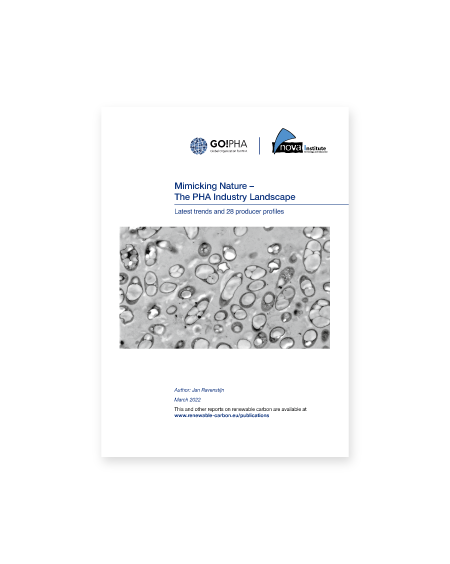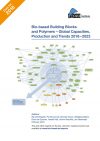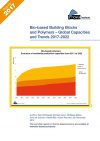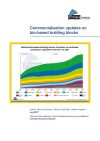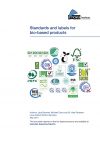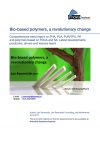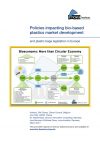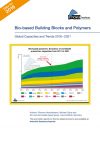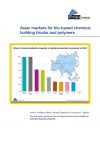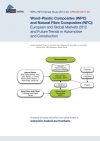Showing 21–33 of 33
-
Succinic acid: From a promising building block to a slow seller – what will a realistic future market look like?
Markets & Economy
44 Pages

2019-10
100 € – 500 € ex. tax
Plus 19% MwSt.Press
release Select
licenceLevulinic acid and succinic acid – A realistic look at the present and future of two versatile bio-based platform chemicals and their market development
Two new market reports published by nova-Institute shed light on the current and future market situation of these previously acclaimed promising bio-based building blocks
Both chemicals, levulinic and succinic acid, were selected twice as promising bio-based building blocks for the chemical industry. While a strong hype pushed exaggerated market expectations for succinic acid, levulinic acid developed in secret.
A comprehensive and especially realistic view on the production and market potential of both bio-based building blocks compared to their fossil-based counterparts is given. Although both still have a high chemical potential, they have fallen short of technology and market demand expectations. Current market data combined with ongoing technology development and an expected decrease of oil prices has led to a new carefully estimated future market growth for both levulinic and succinic acid.
-
Bio-based Building Blocks and Polymers Global Capacities and Trends 2018-2023
Markets & Economy
388 Pages

2019-02
100 € – 500 € ex. tax
Plus 19% MwSt.Press
release Select
licence2018 was a very good year for bio-based polymers: Several additional capacities were put into operation
The new market and trend report “Bio-based Building Blocks and Polymers – Global Capacities, Production and Trends 2018-2023” from the German nova-Institute shows capacities and for the first time also production data for all bio-based polymers.
In 2018 the total production volume reached 7.5 million tonnes – these are already 2% of the production volume of petrochemical polymers. The potential is much higher, but is currently hampered by low oil prices and a lack of political support.
-
Bio-based Building Blocks and Polymers – Global Capacities and Trends 2017-2022
Markets & Economy
184 Pages

2018-05
100 € – 500 € ex. tax
Plus 19% MwSt.Press
release Select
licenceStrong growth in bio-based building blocks and moderate growth in bio-based polymers
New comprehensive market and trend report “Bio-based Building Blocks and Polymers – Global Capacities and Trends 2017-2022” published by German nova-Institute
The production capacities of bio-based polymers continue to grow at around 3 to 4% per annum, i.e. at about the same rate as petrochemical polymers. Therefore, the market share of bio-based polymers in the total polymer market remains constant at around 2%. But the individual development of different bio-based polymers varies considerably. While some are virtually collapsing compared to previous forecasts (e.g. bio-PET), many are showing constant or slightly increasing capacities and a few are even showing significant growth (such as PLA). Additionally, for some bio-based polymers such as PHA, PEF, bio-PE and bio-PP, the prospects for the future are quite positive. Overall, the market environment remains challenging with low crude oil prices, little political support and partially underutilized capacities. Until now, the biodegradability of some bio-based polymers has not yet been able to generate a real advantage globally.
The new report is more than just an update, it differs from the previous versions in structure and content. It contains comprehensive information on capacity development from 2011 to 2022, per building block and polymer as well as information on 102 individual polymer producers. A total of 17 bio-based building blocks and 15 polymers are covered in the report. In addition, the new issue includes analyses of market developments per building block and polymer, so that readers can quickly gain an overview of developments that go far beyond capacity figures.
-
2017-07
100 € – 500 € ex. tax
Plus 19% MwSt.Press
release Select
licenceCommercialisation and development of novel bio-based building blocks are discussed in detail in nova-Institute’s new trend report
With the many shifts in economic and political trends over the last year, many bio-based investments are focusing on the core of the Bioeconomy: bio-based building blocks and platform chemicals. nova-Institute’s preliminary market study “Bio-based Building Blocks and Polymers – Global Capacities and Trends 2016–2021”, reports on seventeen building blocks with an estimated total production capacity of 2.4 million tons in 2016, expected to reach 3.5 million tons in 2021, and with a CAGR of 8%.
Commercialisation and development of these novel building blocks are discussed in more detail in the new nova Institute trend report, “Commercialisation Updates on Bio-Based Building Blocks”. The rise and wane of the markets for several established bio-based building blocks are also discussed fully including various technology processes, feedstock usage, supply/demand, and pricing whenever available for both incumbent petrochemicals and their bio-based chemical alternatives. -
2017-05
100 € – 500 € ex. tax
Plus 19% MwSt.Press
release Select
licenceNew trend report highlights certifications and labels for bio-based and biodegradable materials for the European market. Get the latest info on possibilities for feedstock, bio-based content and end-of-life options.
It is not always easy to communicate the benefits of bio-based and/or biodegradable materials to the market. Europe is working on standards and norms as one key area to promote bio-based materials. But what do you need to get your product certified?
The new trend report “Standards and labels for bio-based products” provides a comprehensive overview and a summary of already existing certification and labelling schemes applied to bio-based materials. The certified issues include: Feedstocks used, measurable bio-based content of the products and biodegradability properties for different environments. It also looks at the latest insights into the possible connections between ecolabels, especially the EU Ecolabel, and bio-based products and what this means for producers and consumers of bio-based plastics.
-
2017-04
100 € – 500 € ex. tax
Plus 19% MwSt.Press
release Select
licenceThe comprehensive trend report presents latest developments, producers, drivers and lessons learnt especially for PHA, PLA, PUR/TPU, PA and polymers based on furandicarboxylic acid (FDCA) and succinic acid (SA)
The conversion from hydrocarbons to carbohydrates and CO2 as feedstock to produce chemicals and polymers becomes more significant every year. It is anticipated that bio-based chemicals like adipic acid, butanediol, furandicarboxylic acid, lactic acid and succinic acid will form bio-based chemical platforms worth more than 30 billion € by 2030. Although these chemicals are to a large extent used for polymer production, there are also other polymer related developments focusing on renewable feedstock use.
The comprehensive trend report presents latest developments, producers, drivers and lessons learnt especially for PHA, PLA, PUR/TPU, PA and polymers based on furandicarboxylic acid (FDCA) and succinic acid (SA). -
Policies impacting bio-based plastics market development and plastic bags legislation in Europe
Policy
74 Pages

2017-03
100 € – 500 € ex. tax
Plus 19% MwSt.Press
release Select
licenceThe newly published report looks at how different parts of the world handle the development of the bio-based plastics sector politically
New trend report highlights policies around the world and their positive and negative impacts on bio-based plastics market developments. A must read for any investor or producer – where is demand expected to increase?
The development of an innovative industrial sector is influenced by many different factors. Among others, the political framework conditions in which such a sector is built play an important role.
-
Bio-based Building Blocks and Polymers – Global Capacities and Trends 2016-2021
Markets & Economy
249 Pages

2017-02
100 € – 500 € ex. tax
Plus 19% MwSt.Press
release Select
licenceIn 2016: 6.6 Million tonnes production capacity, 2% share of all polymers, €13 billion turnover, durable applications are dominating
The worldwide production capacity for bio-based polymers grew by 4% to 6.6 Million tonnes from 2015 to 2016. This represents a share of 2% of the global polymer market. The bio-based polymer turnover was about €13 billion worldwide in 2016 compared to €11 billion in 2014. Production capacity of bio-based polymers is forecasted to increase from 6.6 million tonnes in 2016 to 8.5 million tonnes by 2021.
-
2017-01
100 € – 500 € ex. tax
Plus 19% MwSt.Press
release Select
licenceIncrease on Asian production capacities for bio-based chemicals, building blocks and polymers
New nova trend report “Asian markets for bio-based chemical building blocks and polymers” shows latest data and development in China, Japan, Malaysia, South Korea, Taiwan and Thailand. A global capacity of 2.4 million tonnes bio-based polymers was established in 2016, from which more than 45% of the most important bio-based polymers are produced in Asia.
-
2016-04
100 € – 500 € ex. tax
Plus 19% MwSt.Press
release Select
licencenova-Institute publishes the first comprehensive market study on the consumption of biodegradable and compostable plastic products in Europe: 100,000 tonnes in 2015, market demand could grow to beyond 300,000 tonnes in 2020.
Compostable plastic bags dominate the market for biodegradable plastics in Europe. They not only carry goods and biowaste but also the hopes of the bioplastics industry for huge markets in years to come. The legal framework and composting infrastructure of EU member states were found to be either the bottleneck or the key driver for market development. These are some of the main findings by the expert team at nova-Institute who researched the European market demand for biodegradable polymers by country as well as application, and analysed framework conditions in detail. The market of compostable and biodegradable plastic products grew to 100,000 tonnes in 2015, and could grow to beyond 300,000 tonnes in 2020 – if the legal framework were to be set more favourably.
-
2016-01
100 € – 500 € ex. tax
Plus 19% MwSt.Press
release Select
licenceBrand Views and Adoption of Bio-based Polymers
This trend report gives an overview on different brand strategies.
The report may help to:
- Better know and understand brand owners by showing their vision, targets, commitments and actions which affect or concern the adoption of bio-based polymers
- Analyze their communication and purchasing policies and practices to detect promising approaches for bio-based polymers applications
- The selection is based on major companies owning brands who are acknowledged leaders and frontrunners, or supposedly have such ambitions, or teach us why this has not yet happened.
-
Wood-Plastic Composites (WPC) and Natural Fibre Composites (NFC): European and Global Markets 2012 and Future Trends in Automotive and Construction
Markets & Economy
90 Pages

2015-06
100 € ex. tax
Plus 19% MwSt.Press
release Add to
cartBiocomposites: 350,000 t production of wood and natural fibre composites in the European Union in 2012
The most important application sectors are construction (decking, siding and fencing) and automotive interior parts. Between 10 – 15% of the total European composite market is covered by Wood-Plastic Composites (WPC) and Natural Fibre Composites (NFC). Main authors of the study are Michael Carus and Asta Eder, biocomposite experts of nova-Institute, Germany. The study points out the growth potential of WPC and NFC granulates for injection moulding for all kinds of technical applications and consumer goods as well as in the automotive industry. What’s more, bio-based polymers in combination with wood and natural fibres take on greater significance – applied in everything from toys to automotive interior.
The market report gives the first comprehensive and detailed picture of the use and amount of wood and natural fibre reinforced composites in the European bio-based economy. The analysis covers natural fibre as well as Wood-Plastic Composites in extrusion, injection and compression moulding in different branches and applications.
-
Bio-based Polymers in the World – Capacities, Production and Applications: Status Quo and Trends towards 2020
Markets & Economy
360 Pages

2013-03
100 € ex. tax
Plus 19% MwSt.Press
release Add to
cartEurope’s current position in producing bio-based polymers is limited to a few polymers. However, new developments and investments are foreseen: the first European industrial-scale PLA plant by 2014, the introduction of future PET production facilities by 2015, recent developments in the commercialization of bio-based PBT and further advancements in the field of high-value fine chemicals for PA, PUR and thermosets production.
Although Europe shows a strong demand for bio-based polymers, production tends to take place elsewhere, namely in Asia and America. The European Union’s relatively weak position in the production of bio-based polymers is largely the consequence of an unfavourable political framework for the industrial material use of biomass.
The European market data present the latest findings of production capacities of bio-based polymers in Europe based on the market study published by the nova-Institute in spring this year and its continuously updated database.











